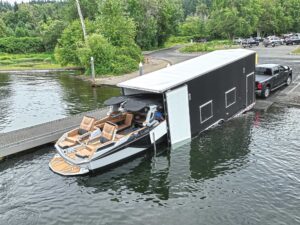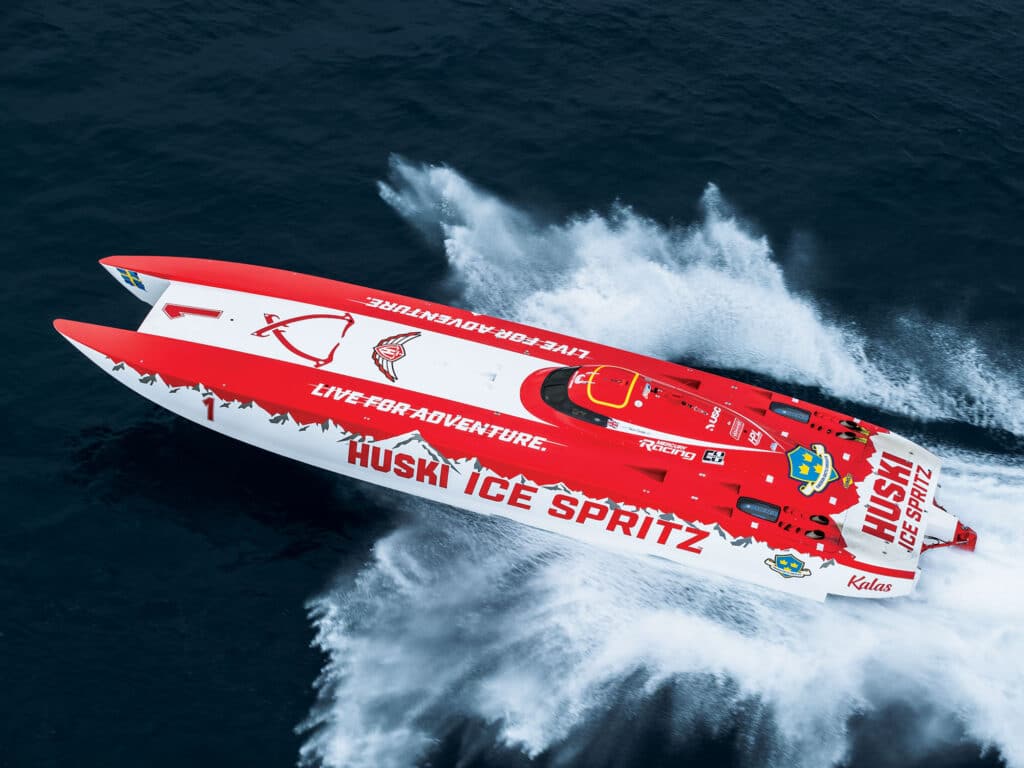
In this age of 70 mph pontoons, 90 mph center-consoles and 150 mph sport cats, it’s pretty easy to experience eye-popping velocity on the water. So, there you are, the wind flapping your cheeks as you hold that throttle to the stop, one watering eye on the speedo as you bump the trim hoping to squeeze out the last bit of speed it will take to be the first boat to the poker-run card pickup. Maybe you even imagine that’s Reggie Fountain, Steve Curtis or Shaun Torrente at the helm of the boat you are pursuing, and instead of a king of hearts, there’s a big trophy waiting at the finish line. Well, dream on, Speed Racer. You’re going fast, but you are not racing, and your production-built motorboat is no race boat.
Steve Curtis throttles a real race boat. The Victory catamaran Huski Chocolate carried Curtis and drivers Travis Pastrana and Brit Lilly to the 2022 UIM Class 1 championship in the Powerboat P1 Offshore series. Last summer, we met Curtis and this boat, now rechristened Huski Ice Spritz, at the Mercury Racing Midwest Challenge in Sheboygan, Wisconsin, the fourth event on the five-race 2023 P1 schedule. The boat is owned by SVEA Racing Inc., based in Stuart, Florida, regarded as the benchmark in professionalism and experience in Class 1 and led by technical director Gary Stray, director of operations Scott Colton and crew chief Patrick Cleaveland.
Curtis, a 59-year-old Englishman and the son of Cougar Powerboats founder and racing catamaran innovator Clive Curtis, claimed his first Class 1 world championship in 1985 in Key West when he was 21 years old. In his career, Curtis has throttled more than 20 world champions. Who would be better to show us under the cowl of a Class 1 race boat than the acknowledged master of throttling racing cats?
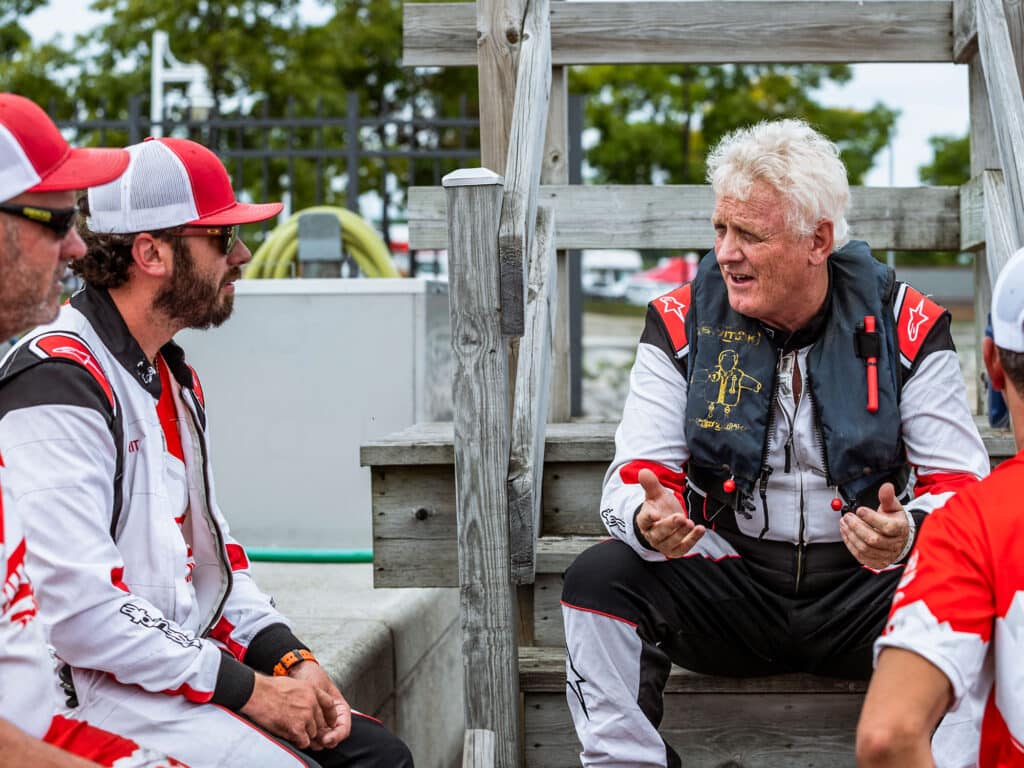
Top Class
Class 1 is the premier category of international offshore powerboat racing. A P1 Offshore event can include a number of classes, but only the Class 1 Championship is sanctioned by the UIM (Union Internationale Motonautique), the world governing body for all powerboating activities. Basic rules for Class 1 dictate a minimum boat length overall of 12 meters (about 39 feet) and a minimum weight of 5,400 kilograms (just over 11,900 pounds). There have been seven boats in the Class 1 field in 2023, ranging in length from the 43-foot Skater Monster Energy/MCON to the 51-foot Mystic dfYoung. The Huski Ice Spritz/SVEA Victory is 47 feet length overall, with a running surface of 41.5 feet, according to Curtis, and a 12-foot beam. Curtis explains that the bigger boats often have an advantage in rough conditions, but the smaller boats can be nimbler in a current on flatter water in a tight, multiturn closed course—the 5-mile course at Sheboygan had 10 turns.
“Courses have become smaller to make the event more spectator-friendly,” Curtis says. “We used to run 40-mile laps and 200-mile races.”
The age of the Class 1 fleet is also surprising. Huski Ice Spritz/SVEA was built in 2007 by the Victory team in Dubai to a Michael Peters design.
“The boat has been rebuilt and repowered a number of times,” Curtis says. “I believe it was originally powered by Lamborghini V-12 engines. The boat has been crashed and repaired. The entire deck has been replaced, and the running surface adjusted as the engine package has changed.”
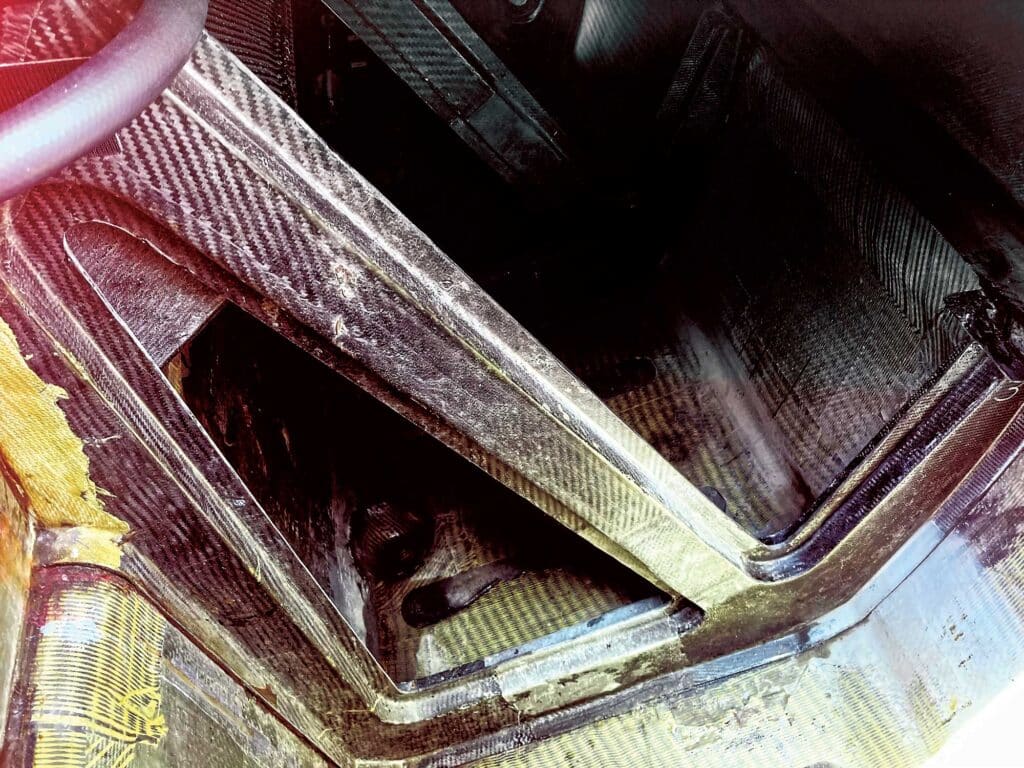
Carbon, Of Course
The overall theme of a race boat is that every element is functional, and this is the key difference between Huski Ice Spritz and your go-fast rig. Speed and safety are all that matter. The hull and deck are laid up with a combination of carbon fiber and Kevlar composite, with foam coring of various density. Bulkheads are carbon fiber, molded in a combination of triangulation and U-channel shape, and bonded within the hull. Each sponson has a pair of steps that are about 1.5 inches deep and a single strake. The tunnel between the sponsons is designed to trap and compress air, which lifts the boat at speed. The tunnel is about 33 inches deep at the bow but only 22 inches deep at the transom.
A V-hull boat could run in Class 1, but the catamaran offers a significant advantage, according to Randy Scism, who helped establish the Victory team as a force in offshore racing before returning to the United States in 1998 to start performance boatbuilder Marine Technologies Inc.
“A comparable V-hull boat will be 20 to 30 mph slower at top speed,” says Scism, who designed the 48-foot MTI Class 1 cat XInsurance/Good Boy Vodka. “In some conditions, it might corner better, but it could never make up the difference in total lap time. The air cushion under a cat can carry 30 to 35 percent of the boat’s weight, so the bottom is not even touching small waves and chop.”
Builders seek to produce a boat that is significantly below the class minimum-weight specification. This allows each team to make weight using lead ballast—water ballast is not allowed—that can be positioned right on the stringers to keep the center of gravity as low as possible to enhance handling and help trim the boat. Weight, either lead bars or bags of lead shot, can be placed aft to lift the bow in calm conditions or forward to hold the bow down in rough water. Fuel tanks are located directly on the boat’s center of balance so that balance does not change as fuel is consumed. At race venues, a crane fitted with a scale lifts the Class 1 boats from the trailer to the water; this way, each boat is weighed every time it goes in and comes out of the water to prevent cheating.
At Class 1 speeds, aerodynamics becomes critical. The boats literally fly over the water, and the deck is flush with the top of each sponson. The enclosed cockpit is a teardrop blister, hatch latches and cleats are carefully recessed and faired, and air intake is accomplished with low-drag NACA ducts. When conditions are ideal, these huge boats appear to levitate with a grace that belies the brutal thrust required to reach speeds that can exceed 160 mph on the open ocean.
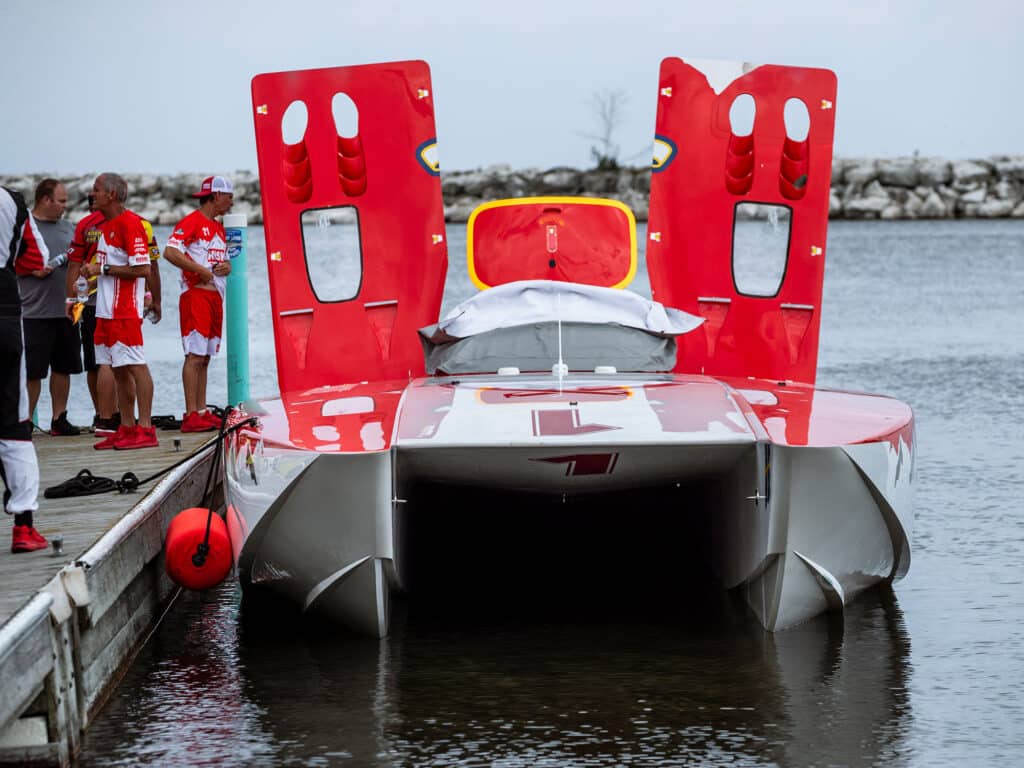
Prescribed Power
There are no surprises below the engine hatches of a Class 1 boat. Since P1 led a revival of the class in 2019, the Mercury Racing 1100 Competition engine has been standard power, a spec engine for the class. The 9.0-liter V-8 engine features Mercury Racing QC4 quad-valve cylinder heads and is boosted by twin turbochargers. Power output is 1,100 hp and 1,100 lb.-ft. of torque per engine on 93-octane pump gasoline. Each big V-8 turns 6,000 to 6,500 rpm. The transmission is the stout model designed for the Mercury Racing 1750 engine with a stronger input shaft and internal components.
“Before the switch to the Merc 1100, we were running engines making 1,850 to 2,000 hp at 7,500 rpm,” Curtis says, “and top speeds pushed 190 mph. Those engines needed a rebuild after each race.”
The point of a specified engine for the class is to reduce cost and ensure power parity among teams with unequal resources. With that in mind, the engines are tightly controlled. Teams are not allowed to make any adjustments or modifications to the engines. With the exception of the valve covers, the engines are sealed with special fasteners. At the beginning of each race weekend, the Mercury Racing support team delivers propulsion control modules (PCM) to each team. The PCM units are painted bright yellow so they are easy to identify. Mercury Racing also installs a data logger on each engine.
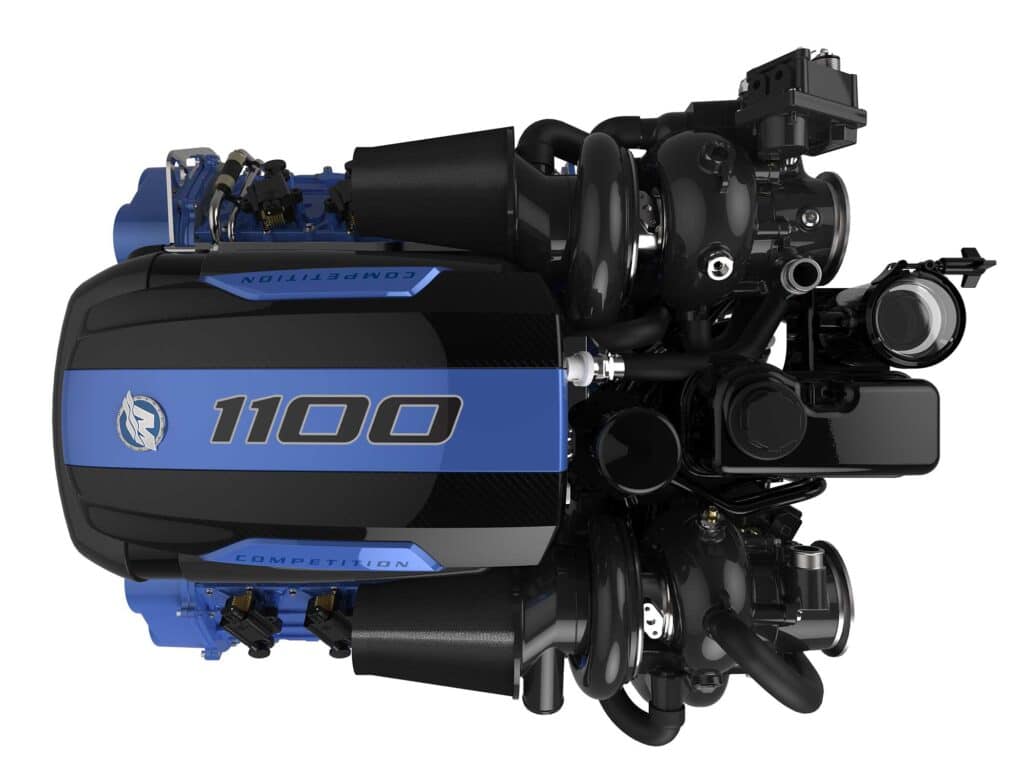
“After every practice and every race, we download the data to make sure it makes sense and that nobody has tweaked on the engines and turned the power up,” says Steve Wynveen, Mercury Racing manager of development engineering. “The idea of Class 1 now is that winning is dependent on driving and boat setup, not on who has the most money to throw at an engine.”
The expectation is that if teams don’t abuse these engines by constantly banging into the rev limiter, each can last the season with just basic maintenance. Teams will put between two and three hours of run time on the engines at each race weekend. Teams are free to install their own PCM for testing between races.
The Huski Ice Spritz/SVEA team engineered a number of quick-disconnect fittings that allow it to remove an engine in about 20 minutes, according to Curtis. This team pulls its engines after each race for maintenance and inspects the bilge and engine mounts below the engines. Typical maintenance includes an oil and filter change, checking the valve lash and adjusting with shims, a compression and leak-down test, checking the turbocharger waste-gate adjustment, and torquing all fasteners and clamps.
Six of the boats in this Class 1 fleet use surface drives based on a BPM model to put power to the water. The Italian drive only articulates in the vertical plane, which provides a limited range of trim, generally less than 15 degrees or, according to Curtis, about 1.5 inches at the propeller. The prop is located about 58 inches abaft the transom. A drop box located on the exterior of the transom allows teams to quickly change gear ratios to best match engine torque to the prevailing conditions. Curtis explains that on today’s short courses, acceleration out of turns is often more important than top speed. Teams using a surface drive are limited to three prop sets but have unlimited gear ratios. Steering is accomplished by a center-mounted rudder—a knife-sharp polished stainless Italian Flexitab model on Huski Ice Spritz—and teams can change rudders based on water conditions.
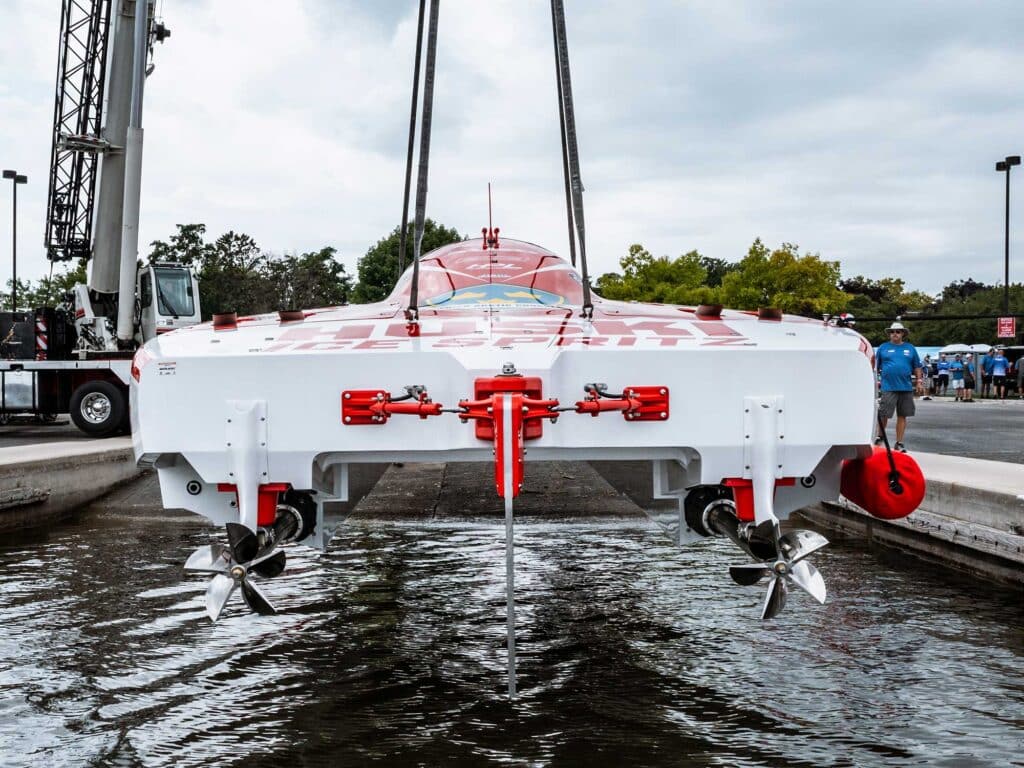
A sterndrive is also permitted in Class 1, but if the sterndrive can steer, the boat is not allowed to use a rudder. The MTI XInsurance/Good Boy Vodka boat is rigged with modified Mercury Racing M6 sterndrives. Trim is retained, but the skegs are cut off and steering is locked. The boat is equipped with a rudder. Teams running sterndrives are allowed an unlimited number of propellers.
“The problem with trying to steer these boats with the sterndrives is that when you turn the drive, one prop is pushed into water and the other into the air coming through the tunnel,” Scism says. “The prop in the air loses thrust. You want to keep both props centered behind the sponsons. I prefer to use the M6 drives for the added trim authority. That drive is plenty rugged for these engines.”
Read Next: How to Boat Safely at Any Speed
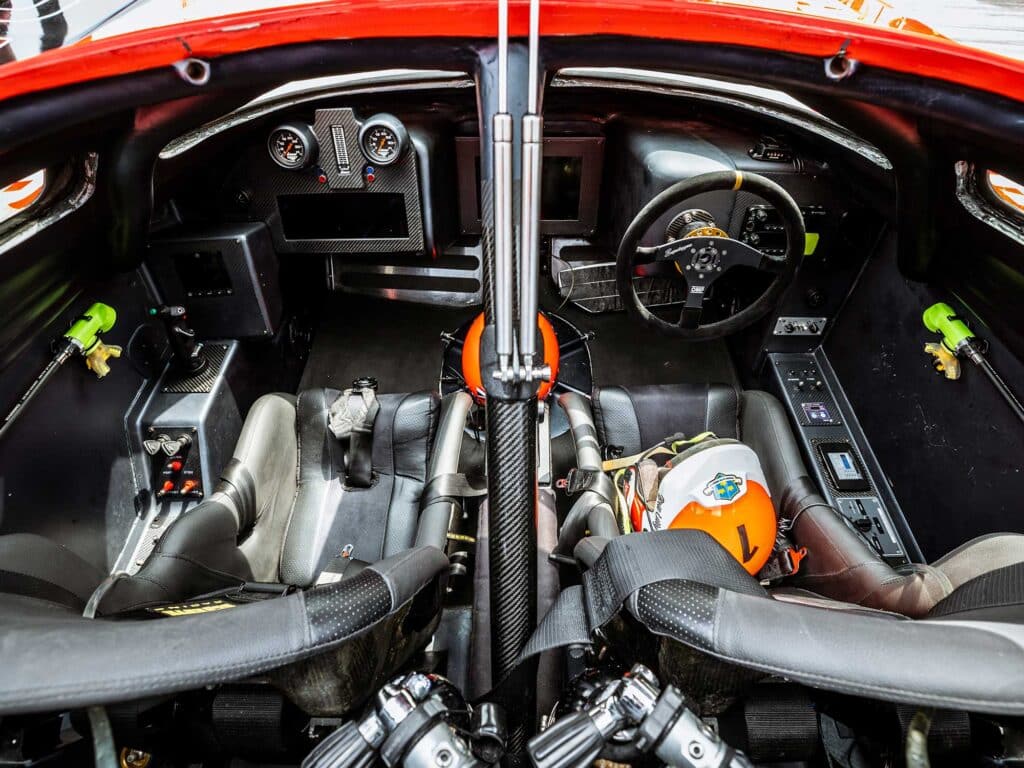
On the Run
Curtis throttles with his right hand gripping a pair of Mercury Zero Effort controls topped with red plastic knobs molded to the shape of his hand. To his left is a fixed, molded grip with radio/intercom control buttons, trim control, and a button to change the screen display. Curtis can communicate with his team using VHF and UHF radios, and a cellular connection. Below is a pair of Mercury ignition keys, which we were surprised to see.
“When we went to the standard Merc 1100 engines, we wanted to retain the entire stock wiring harness to prevent any sort of tampering,” Curtis says. “So, there are the keys, just like on your fishing boat. It was the easiest solution.”
Facing Curtis are a pair of Livorsi turbocharger boost gauges, a Livorsi trim indicator, and a multifunction display usually showing tachometers. In the center of the dash is a Garmin MFD split between navigation and a rearview camera. The driver sits before a quick-release steering wheel with a lap counter on top of the dash, which will also display a yellow-and-red flag signal from race control.
I wish I could describe the sensation of driving Huski Ice Spritz at speed while looking through the slit of a windscreen. But as it turns out, there is not enough liability coverage or legal cover to ever make that happen. Scism says MTI will build you a new 48 Race model to Class 1 specs, with a price tag of $2.2 million to $2.4 million with power. A $500,000 budget will cover a bare-bones Class 1 team for a season, Curtis says, with a well-financed team spending more than $1.5 million. SVEA Racing Inc. brings a crew of 10 to each race with a 70-foot race trailer, a tilting boat trailer and its Kenworth hauler, and a world-champion throttleman. They are not going to a poker run.
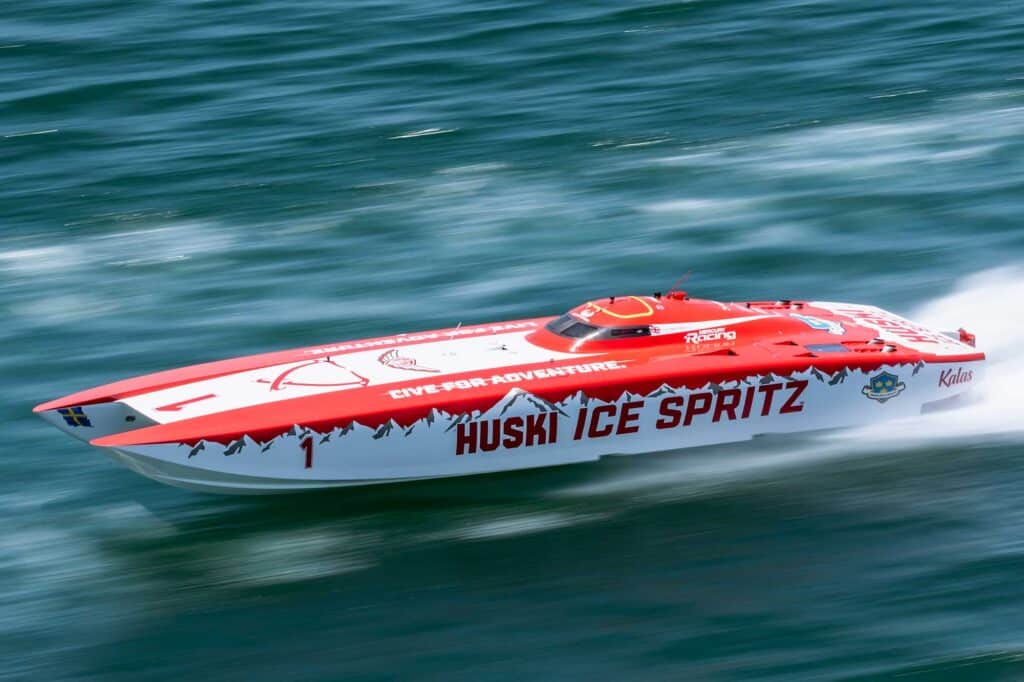
Safety First
When Steve Curtis won his first Class 1 championship, he was standing in an open cockpit. “There was very little concern for safety in those boats,” Curtis says. “If you stuffed the boat, it was very likely you’d be killed.”
Today the driver and throttle work in an enclosed cockpit that is all business. This is not your pleasure boat—there is no Alcantara upholstery, no bass-pumping audio system, and no LED-illuminated drink holders. Cockpit entry is through a hatch secured with four sliding bolts like a bank vault. In Huski Ice Spritz, Curtis throttles from the port seat, and the driver is at the wheel to starboard. Deep bucket seats have 2 inches of suspension travel, and the crew is strapped securely in place. “During a race, it can actually get rather violent in here,” Curtis says. “It’s not very noisy, but there is a lot of vibration, even in smooth water, because the boat is so rigid. We can feel pretty beat up after a race.”
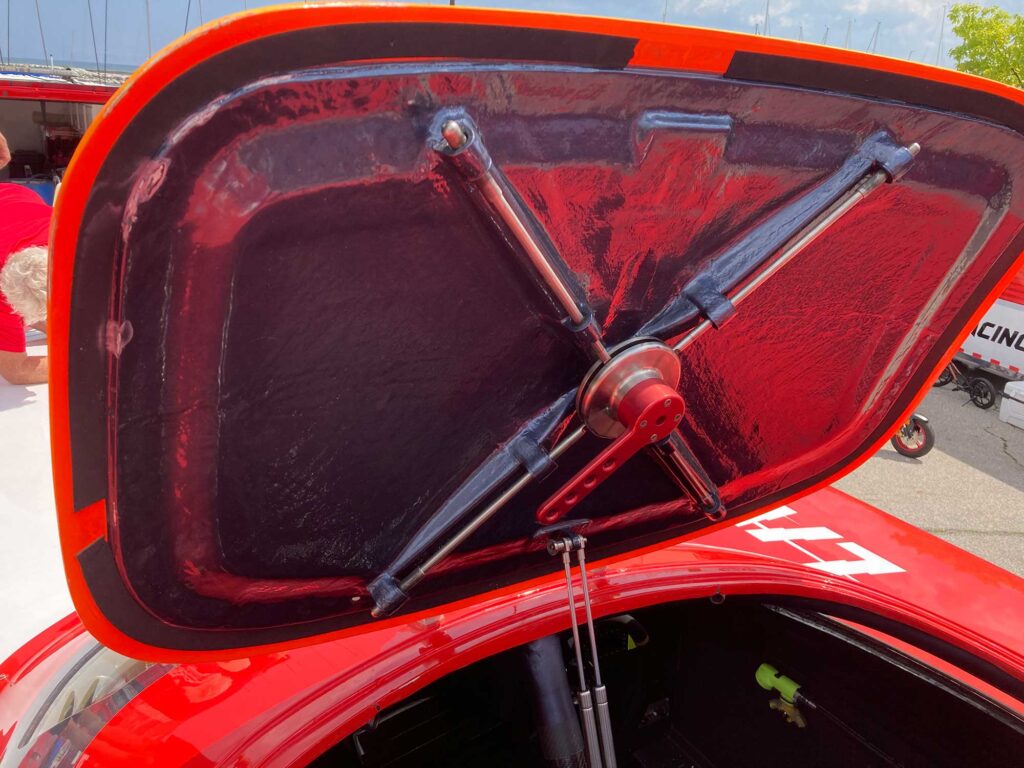
A cage of carbon channels surrounds the cockpit, which Curtis says is backed by a very thick bulkhead. Crush zones around the cockpit are designed to absorb energy on impact. The interior is raw and black, with no thought of cosmetics. The forward portion of the cockpit structure is formed by a ¾-inch-thick polycarbonate shield modeled after a fighter-jet canopy. The clear portion is minimized for further crew protection. There’s an emergency escape hatch in the floor for egress if the boat flips. The driver and throttle have a 10-minute emergency air supply.

